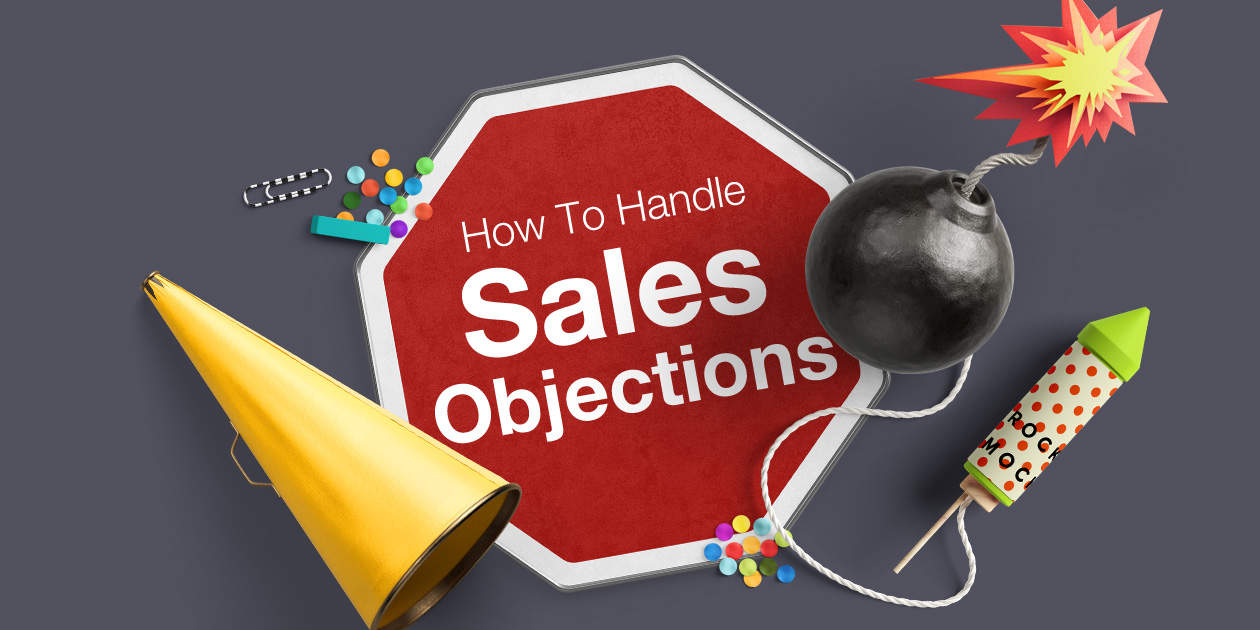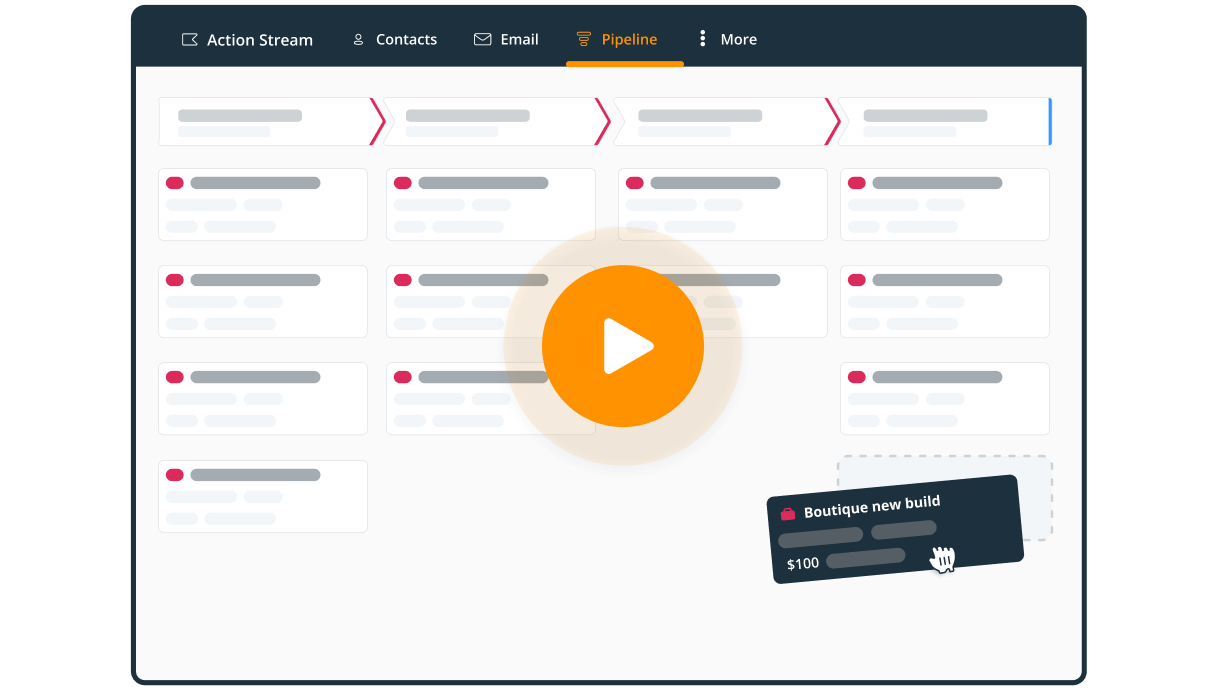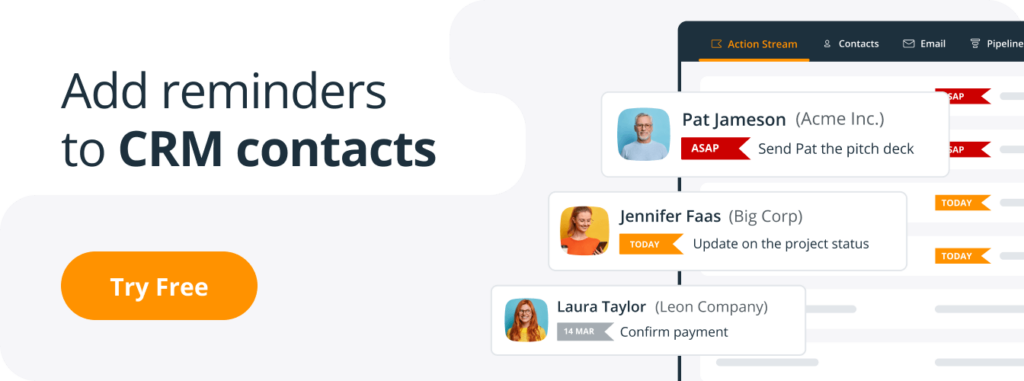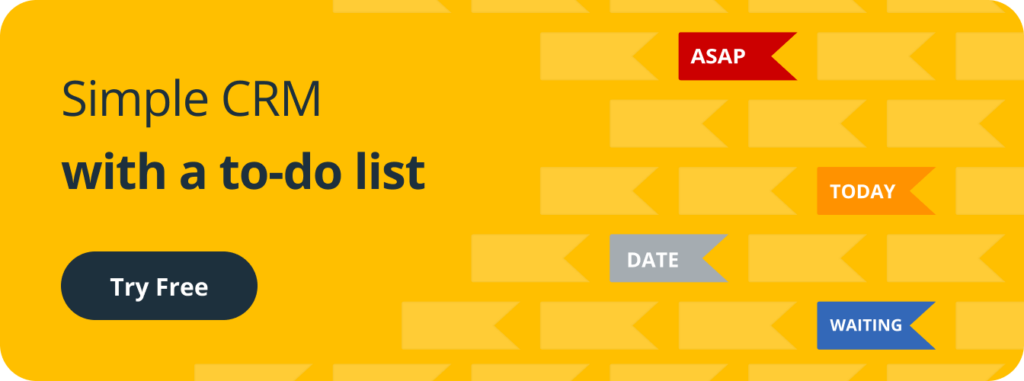

How to overcome sales objections: 52 examples for objection-handling

We’ve all been there, right? You’re in the middle of your perfectly rehearsed sales pitch, and then WHAM! Out of nowhere, an objection pops up.
Feels like a punch in the gut, doesn’t it?
But here’s the thing: objections in sales are as natural as rain in April.
As much as we’d like to avoid them, they’re bound to happen because buying involves change and decisions, and who doesn’t hesitate a bit when faced with those?
You’ll need to learn to deal with them regardless of whether you are in B2B or B2C sales or whether you run a service business or a product company.
What is a sales objection?
In other words, to object is not the same as to reject.
In sales, objection and rejection are daily occurrences. It’s important to remember that no matter how great your offering is, you’ll still face objections.
Knowing that sales objections are only offered by engaged prospects means that there is also hope. So the need to develop probing techniques to uncover the source of the objection should be at the top of a salesperson’s mind.
“A sales objection is not a rejection; it is simply a request for more information.”
7 reasons for sales objections
According to Dave Buster, “the first objection is rarely the real issue”. You have to probe around and dig deeper to discover what lies beneath.
If you reframe your thinking, you will see that the sales objection is a sign that you haven’t sold enough value to your client (or at least, that you are not speaking with the right person).
Clients might also object based on the fact that they don’t feel that it is the right match for them.
Depending on your industry and the type of people you are dealing with, the sales objections may vary.
But some constant underlying factors pop up.
Objecting to the sales price can be a mask for many different reasons.
“The sales objections you receive are not always indicative of what you think they are.”
1. Perceived lack of value
If a prospect doesn’t see the value your product or service can provide to them, they’re likely to object. It’s crucial to communicate the unique benefits and value proposition clearly and concisely.
If you don’t highlight your product’s benefits that address the client’s pain points, your prospects might struggle with seeing the value you provide. That’s why using data, case studies, and testimonials is so crucial for addressing sales objections.
2. Budget constraints
Quite often, prospects might object to the price. This could be due to budget limitations, or because they don’t perceive your offering to be worth the asking price. Budget constraints often hide behind many sales objections.
Dealing with such objections requires preparation. It’s important to be transparent and open about pricing from the beginning and focus on your ROI when relevant.
3. Wrong timing
Sometimes, the reason behind a sales objection is simply a matter of timing.
The prospect might be interested but not ready to commit at this moment. In this case, they don’t see the need or urgency to solve this business problem. Their current solution may ‘work fine’ or they may just be resistant to acknowledging the need for change.
In sales, there’s no such thing as “right person, wrong time”. The right prospects are the ones who are ready to buy. Convincing someone to buy something that they don’t need might lead to higher revenue in the short term but is not a sustainable business strategy.
4. Skepticism and doubts
Prospects might question whether your product or service can deliver the promised results. This is particularly common with new and unproven solutions.
To address this sales objection, you need to provide evidence. As you can see, the majority of sales objections come from not understanding whether your product can deliver the promised results.
5. Lack of trust
If the prospect doesn’t trust the salesperson or doesn’t feel a connection with them, they’re likely to object regardless of the product or service’s merits.
Your solution might seem right but the client may not know you or your company and may not trust that you can fulfill your obligations. Your company may be too new for them to take a chance or be associated with bad comments/reports.
6. Wrong decision maker
Sometimes the reason behind a sales objection is quite simple: You are not speaking with the correct person.
Not everyone can allocate funds. Larger companies may rely on purchasing managers to make purchasing decisions. As a result, the person you are selling to may not know how to buy or how to bring a request to buy to their CFO.
That’s why it’s so important to get the lead qualification right. If you qualify leads correctly, you’ll deal with fewer sales objections.
7. Lack of awareness
Wrong timing is one of the reasons behind sales objections.
But maybe your client doesn’t know that they have a problem—or that they need to solve it.
In this situation, the client is not aware of the scale of the problem facing their business. Then you’ll need to take a more consultative approach to your selling strategy. This is where a close alignment between sales and marketing is key.
How to handle sales objections?
Sales objections aren’t the end of the road. Often, they’re an invitation to address concerns, fill in gaps in understanding, and reinforce the value your offering brings to the table.
Effective objection handling is a critical skill for sales professionals. At its most basic, a sales objection is a call for more information or clarification.
Every salesperson will have their own approach to handling them. More often than not, the approach used across will have elements that can be attributed to the following frameworks: ACT, ACAC, and LAER model.
Here are the top 10 strategies to master the art of handling sales objections.
1. Listen to understand, not to respond
We often get so caught up preparing the perfect reply that we forget to listen to what the prospect is saying. So, instead of interrupting with a quick response, let the prospect voice their concern fully. This not only builds trust but also helps you understand the real issues at hand.
Use active listening to show the client that you are engaged with what they are saying. Active listening involves smiling, making eye contact, sitting upright, nodding your head, engaging, and summarizing what is being said to you.
2. Empathize and validate their concerns
“I understand where you’re coming from…” Start your responses like this to make the prospect feel heard and valued. Remember, people don’t care how much you know until they know how much you care.
Acknowledging helps to build a rapport with the client and shows empathy for their situation. This lets the client know that you will listen to what they say they want and you are willing to work towards a common goal.
3. Ask clarifying questions
Dig deeper to uncover the real issue. Ask open-ended questions, it might lead you to an objection you can actually address.
Every clarification breeds new questions and with these questions, you can dig deeper into understanding the client’s problems. Clarification of the client’s position ensures that you see the world from their point of view. When you clarify, you are making sure that you understand their reason for objecting so you can help to overcome it.
4. Position your solution as the answer
Once you’ve identified the real objection, tie it back to your solution. Show them how your product or service not only solves their problem but also offers added benefits they hadn’t considered.
5. Follow up with proof
Testimonials, case studies, and data can be your best friends in reinforcing your points. Got a customer who saw a 35% increase in efficiency after using your product? Share that story.
Numbers add credibility to your claims.
6. Stay cool and collected
In the face of objections, it can be easy to get defensive. However, keep your cool. Take a deep breath, maintain your composure, and let them know you’re there to help, not to argue.
Remember, everyone loves buying but nobody likes being sold to.
7. Leverage the power of storytelling
People relate to stories. If you have a relatable example of someone who had the same objection but ended up benefiting from your product or service, share it. Stories create connections and can often be more convincing than facts or figures.
8. Acknowledge and pivot
Sometimes, you can’t overcome the objection outright. In these cases, acknowledge the validity of their concern and pivot to a related area where your product or service shines.
For example, if price is the hurdle, focus on the value and return on investment your solution provides.
9. Offer a trial or demonstration
If words aren’t enough to describe what your product can do, show them. A hands-on trial or a detailed demo can provide tangible proof of your product’s value, reducing uncertainty and overcoming objections based on perceived risk.
10. Maintain positivity and persistence
Last but not least, stay positive and be persistent. Rejection is a part of sales. If one approach doesn’t work, be ready to try another. Keep the conversation going, stay cheerful, and remember that perseverance is often the key to success.
Every objection is an opportunity in disguise. Master these techniques and turn those ‘No’s into a resounding ‘Yes’!
52 sales objections and ways to handle them
The first step towards objection handling is to research, expect, and prepare.
If you’re still trying to understand your clients, asking questions will shed more light on the situation. As you become more experienced, specific objections will begin to show up regularly. So now you can begin to customize your response for them.
“The top 1% of the best salespeople have a clear understanding of the exact response to the top 8 objections your prospects will have.”
Here’s a list of the most common sales objections, what they mean, and how to handle them:
Money-related objections
Price and budget constraints are the reasons behind many objections in sales. Here’s what you can expect to hear and how to handle this.
1. “It’s too expensive.” This usually means they’re not seeing the value. Instead of lowering the price, amplify the value. Highlight the savings or gains they’ll get in return.
2. “We don’t have any budget left.” Suggest a scaled-down version of your solution or flexible payment term. Show them that you can work with their financial constraints.
3. “Your product is overpriced.” Showcase the superior features and benefits of your solution which ustify the cost.
4. “I can get a cheaper version somewhere else.” Reiterate the value and benefits they’d be missing out on with a cheaper solution. To handle this objection, you need to know the market very well and understand how your solution compares to others.
5. “Your pricing is too complicated.” Explain the reasons behind your pricing structure. Offer to walk them through each plan, its ROI, and its benefits. They might not need your most expensive plan, so if you’re open with them about the most suitable plan for their needs, it’ll help build trust.
6. “We’re cutting costs right now.” Explain how your solution can help them cut costs in the long run. Provide case studies or ROI calculations with case studies from existing clients and how they’ve saved money with your solution. Consider a multi-step implementation process to align with their budget constraints.
7. “Your competitors are offering significant discounts.” Explain the reason behind the price difference and highlight any additional services or features included in your pricing that competitors might charge extra for in the long run.
8. “We’ve already allocated our budget for this year.” Ask about their budget planning cycle and offer to follow up later this year. In the meantime, suggest a smaller project or trial to let them experience your product’s value before fully committing.
Competitor-related objections
Most likely your business has competitors, so you can expect some objections to be related to your competition:
9. “We’re already using another solution.” Focus on what makes you unique. What can your product or service do that their current solution can’t? Keep in mind how this uniqueness can benefit the client.
10. “We had a bad experience with a similar product.” Assure them that you’re different. Highlight how your product has improved or is superior to the one they had issues with.
11. “We are under contract with another vendor.” Ask about the contract duration and revisit the prospect when they’re open to exploring new vendors.
12. “We have an in-house solution.” Ask questions about their in-house solutions and if they have any issues with it. Discuss the potential benefits of your solution over their in-house one.
13. “We can build this in-house.” Compare the total cost of building in-house vs. using your solution. Mention the support and updates they’d receive.
14. “We’ve had reliability issues with similar products.” Share uptime statistics, your performance measures, and testimonials from your clients who switched from competitors.
Readiness-related objections
Sometimes a prospect might be interested in your solution in the future but they are not the best fit right now. Here are the most common sales objections when the timing is not right:
15. “I’ll think about it.” Don’t let the client leave without providing specific facts and figures with which they can compare. Agree on a Next Action with them and offer a day and time when you will personally be available to discuss it.
16. “There’s too much going on right now.” Offer to help with the transition. Make it as easy as possible for them to start benefiting from your solution. If this doesn’t help, try to reconnect with them after a while. It’s important to be persistent but you don’t want to overwhelm prospective clients.
17. “We’re not ready to make a decision yet.” Be respectful and patient. Keep the lines of communication open and follow up at a later date.
18. “We’re not looking for any new solutions right now.” Maintain the relationship and try to understand their needs for potential future opportunities.
19. “We’re in the middle of a restructuring/merger.” Schedule a follow-up for when the dust settles. If relevant, explain how your solution could ease the transition or bring value in post-restructuring period.
20. “I need to talk to my team”. Not only is this okay but you should encourage it. Offer to provide any materials or talking points they might need for the discussion with the team. Be as supportive as possible.
21. “I can’t decide”. Eliminate excess information. Focus on the key points for the client and answer their questions on each. If you have multiple offerings, offer your personal preference, if the client asks. Also, try to identify what’s causing the hesitation. Is it a feature they need? Do they require more testimonials? Address the issue.
Need-related objections
In some cases, prospects might be quick to dismiss your solution if they think there’s no need in it. This doesn’t always mean that you’re speaking to the wrong prospect. Sometimes it just takes time to explain the value behind your solution:
22. “We’re happy with the way things are and don’t need it.” Be alert to the needs of your client. Don’t try to push more on them than they need. Do they need more space, more time, better methods, or just the basics?
23. “We don’t see the need for this.” Show them the stats or case studies. Help them visualize the benefits that they’re currently missing out on.
24. “We’re not sure about return on investment (ROI).” Provide concrete data and testimonials to illustrate how your product has improved ROI for similar businesses.
25. “We don’t see how this fits into our current tech stack.” Share some info on your existing integrations, future plans, and API documentation. If needed, schedule a demo with their IT team.
26. “Your solution seems overkill for our needs.” Show how they can start small and grow with your product. Scalability is attractive.
27. “We’re not sure if this aligns with our long-term strategy.” Ask about their long-term goals and show how your solution can adapt to support those objectives.
Solution-specific objections
28. “Your product is too complicated.” Try to find the reasons why they think so and how you can help them understand the product better. Offer training or a demo. Show them how easy it is to use.
29. “Your solution doesn’t integrate with our current systems.” If you do, show them how. If you don’t, are there workarounds or is this feature on your roadmap?
30. “Your solution doesn’t have ‘X’ feature.” If it’s a feature you’re planning to implement, let them know. If not, focus on your key features that can compensate or overshadow the missing one.
31. “Your solution isn’t customizable enough.” Showcase how your product can be customized to meet their needs.
32. “Your product doesn’t have all the latest features we’ve seen elsewhere.” Explain your product development philosophy and roadmap. Mention how your core features solve their primary needs more effectively than competitors with bells and whistles.
Credibility-related objections
33. “This sounds like a scam.” Provide ample proof, testimonials, case studies, anything you’ve got to prove your credibility.
34. “I’ve never heard of your company.” Share your company’s history, notable achievements, and customer testimonials to build credibility.
35. “You’re just a small company, can you handle our volumes?” Assure them of your capacity by referring to experiences with similar-sized clients.
36. “We’ve had a bad experience with your company in the past.” Address the issue, apologize sincerely, and discuss how things have changed since then.
37. “Your solution seems too new and untested.” Share any beta testing results, testimonials from early adopters, and your development roadmap.
38. “Your company isn’t local, and we prefer local vendors.” Highlight the advantages of working with a non-local specialist or assure them that you can provide them with the support they need even remotely.
39. “Your team lacks the industry-specific experience we need.” Focus on your transferable skills and how your unique perspective can bring unusual and innovative solutions. Offer to partner with industry-specific experts if needed.
40. “Your firm doesn’t have a big brand name to back you up.” Highlight the personal commitment. Offer client testimonials and references to build credibility. Emphasize how your firm’s small size allows for more flexibility.
41. “Your portfolio/testimonials don’t have big brand names.” Focus on the personalized attention your clients get. Share relevant case studies with significant results. Explain why working with you means direct access to top-level talent.
42. “Your team is small. What if someone key to our account leaves?” Explain your collaborative work process where multiple team members are familiar with each account. Offer to include a continuity clause in the contract.
Implementation-related objections
43. “We don’t have the manpower to implement this.” Show how your solution can save time and resources in the long run.
44. “We’ll lose all our data if we switch to your product.” Assure them about your data migration capabilities. Prove to them that their data is safe during the transition.
45. “We’re not sure your product will scale with our growth.” Demonstrate your product’s scalability with examples from current clients. Share case studies of long-term clients who have benefited from your product.
46. “We’ve never outsourced this before.” Explain the benefits of outsourcing, such as cost savings and access to specialized expertise. Offer a trial period.
47. “We don’t have the technical expertise to use your product.” Bring up the quality of your customer support and training programs. Offer dedicated onboarding assistance.
48. “This will require too much change to our existing processes.” Ask about their current processes and show how your solution can integrate with them. Offer a step-by-step implementation to minimize disruption.
49. “We’re worried about the learning curve.” Showcase your user-friendly interface and provide examples of quick adoption by other clients.
Security-related objections
50. “We’re worried about data security.” Share more info about your security measures and compliance certifications. If needed, offer an in-depth demo or conversation.
51. “We’re worried about vendor lock-in.” Show how easy it is for them to download their data. Be upfront and helpful about any exit strategies they have.
52. “We’re concerned about third-party access to our data.” Give a proper overview of your security policies and procedures. Explain your vetting process for any third-party tools or services you use. Offer to sign additional non-disclosure agreements if needed.
Core issues behind all sales objections
Here’s the kicker—regardless of the number or variety of sales objections, they often boil down to the same core issues.
It’s all about understanding your market, recognizing the most common pain points, and having a crystal-clear picture of how your solution stacks up against the competition. All of these elements together will help you overcome objections.
Think of it this way: You’re playing a game of chess, and you’ve got to know your opponent’s potential moves inside and out.
By taking this approach, navigating the world of sales objections won’t feel like an uphill battle, but more like a dance—you anticipate the steps, you pivot, you adjust, and before you know it, you’re moving in harmony.
It’s all part of the game, part of the journey. And with time, practice, and a deeper comprehension of your clients and your product, it’ll all become a lot easier.
Turning sales objections into a yes
In the end, it all comes down to this—sales is not just about closing deals; it’s about building relationships. It’s about understanding your prospects’ needs and working to solve their problems, even if that sometimes means referring them to a competitor (if your solution is really not a good fit for them).
As a salesperson, you need to be resilient, and adaptable, and always keep your customer’s best interests at heart. If a deal doesn’t close, that doesn’t reflect on you as a person—it’s just a sign that the solution wasn’t the right fit. What matters is how you respond.
So, take a step back, learn from the experience, and remember: every interaction, every objection, every ‘no’ is an opportunity to learn, to improve, and to ultimately become a better salesperson.
If a conversation with a prospective lead doesn’t result in a sale, then maybe it is time to move on to another prospect. Always remember to end on a positive note, even if they have rejected your offering on this occasion. You never know what the future might bring business-wise for them.













Brian:
Great information Brian, thanks for sharing it.
I have found Victor Antonio to be a master at “blocking objections” rather than overcoming them. From experience I’ve found that when I’m explaining, 99 time out of 100 I’m losing.
Once objections are raised (especially verbally), our brains are hardwired to stand by them. The psychological principle known as cognitive dissonance is particularly stubborn for “voiced” opinions.
Victor explains his theory and the challenge resolution here: https://youtu.be/mUNT4dO9nxM
Keep up the great work!
Dave Price
Atlanta, GA
Thanks for your comment Dave, and for sharing the video link – it’s great to see different techniques we can use to handle objections 🙂
Can you please state examples on how to ” end on a positive note” with a prospect when they have rejected our offering on this occasion?
Hi Norma,
I think ending on a positive note is as much about how you conduct your self in the face of rejection. Just because a prospect has turned down your offer or is not interested at the moment doesn’t mean that there is no future. Accept their decision, suggest that you will reach out again in future and put them back into your marketing funnel to stay in contact.
None of that would work on me. You call me cold about something I am not interested in and your not changing my mind. Unless I am actively exploring a solution to a problem I am aware of its not going to happen. This objection blocking stuff might work selling simple products but not C level consultive solutions that are complex and expensive. Not going to happen.
Thanks for the feedback Rob. I understand these tips may not work on everyone, but they may give sales people an outline of where to start / how to handle them better. It may also help them to realize that their process does not work at all and may need to go back to the drawing board! Keep in touch! Carmel